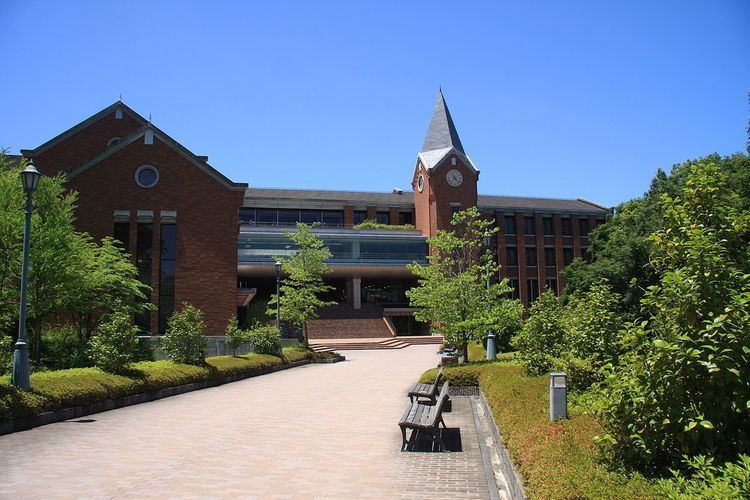Motto in English I am the true vine President Hirō Kaga Total enrollment 6,549 (1 May 2014) Founder Joseph Hardy Neesima | Academic staff 836 Acceptance rate 26.5% (2014) Founded 1949 | |
 | ||
Motto Latin: Ego sum vitis vera Established Founded 1876 (1876)Chartered 1949 Similar Doshisha University, Bukkyo University, Hanazono University, Kyoto Prefectural University, Kyoto Institute of Technology Profiles | ||
Doshisha Women's College of Liberal Arts (同志社女子大学, Dōshisha joshi daigaku) is a private women's college in Kyotanabe, Kyoto, Japan. The predecessor of the school was founded in 1876, and it was chartered as a university in 1949.
Contents
History
In 1876, Protestant educator Niijima Jō founded the Doshisha Girls' School with the assistance from his wife Niijima Yae. The original school was located at the former residence of Yanagihara family (a division of Fujiwara clan) inside the Kyoto Imperial Palace. Since the main Doshisha University founded the year prior was not co-educational at the time, the women's school was founded to promote the importance of women's education.
In 1930, it was renamed to Doshisha Women's College and maintained as a vocational school. In 1949, the vocational system was abolished, and the school was granted university status and the present name under the new National School Establishment Law.
Faculties, Departments and Graduate Schools
Kyoto
Doshisha Women's College has two campuses at Kyotanabe in southern Kyoto and at Imadegawa in central Kyoto. Kyoto, Japan’s ancient capital from 794 to 1867 (there are various theories regarding the last year), has a 1,200-year history and attracts tourists from around the world. Traditional culture and arts such as tea ceremony and flower arrangement have developed and have been preserved in Kyoto. The city has hundreds of Buddhist temples and Shinto shrines, including some designated as World Cultural Heritages, where many festivals such as Aoi Matsuri, Gion Matsuri and Jidai Matsuri are held throughout the year. At the same time, Kyoto is a highly modern city, home to many of Japan’s leading high-tech industries and a thriving international community.
Kyotanabe Campus
The Kyotanabe campus is located in Kyōtanabe, Kyoto. It was opened in 1986 as Tanabe campus, part of the Kansai Science City until it was renamed in 1999. The campus now houses 4 faculties (Faculties of Liberal Arts, Contemporary Social Studies, Pharmaceutical Sciences and Nursing ) and 3 graduate schools.
Imadegawa Campus
The Imadegawa campus is located in the former residences of Nijō family and Fushimi-no-miya, situated in the center of Kyoto City, across from Kyoto Imperial Palace. It is located adjacent to the Imadegawa campus of Doshisha University. Inside the campus, the two buildings James-kan (built in 1913) and Eiko-kan (built in 1932) are registered as Tangible Cultural Properties of Japan. This campus houses 2 faculties (Faculties of Culture and Representation and Human Life and Science) and 2 graduate schools.
Student life
While the pursuit of knowledge is the fundamental principle behind all higher learning academies, it is also essential that universities support and guide students toward personal development. At Doshisha Women’s College, students are encouraged to independently plan and actively participate in various club activities and events. These include religious retreats, summer / spring camps, sports festivals, assemblies, and the college’s two unique events: the “Doshisha Eve” and “Shakespeare Eve”. Through these extracurricular programs, the college hopes to inspire and foster a spirit of cooperation and independence among young women.
Festivals
Club Activities
There are a total of 53 official clubs and circles as extracurricular activities (as of Apr. 1, 2015). These clubs are classified into four categories: Religious Club, Cultural Club, Sports Club, and Circle.
Alumni
As of 2012, around 11.6% of undergraduates were able to find employment in one of the top 400 companies in Japan, which places them third overall among women's universities in Kansai area, after Nara Women's University and Kobe College.
List of Partner Universities and Colleges
United States of America (14 institutions)
Canada (11 institutions)
United Kingdom (11 institutions)
Australia (5 Institutions)
New Zealand (1 institution)
Germany (1 institution)
China (2 institutions)
Taiwan (2 institutions)
Korea (1 institution)
Thailand (1 institution)
